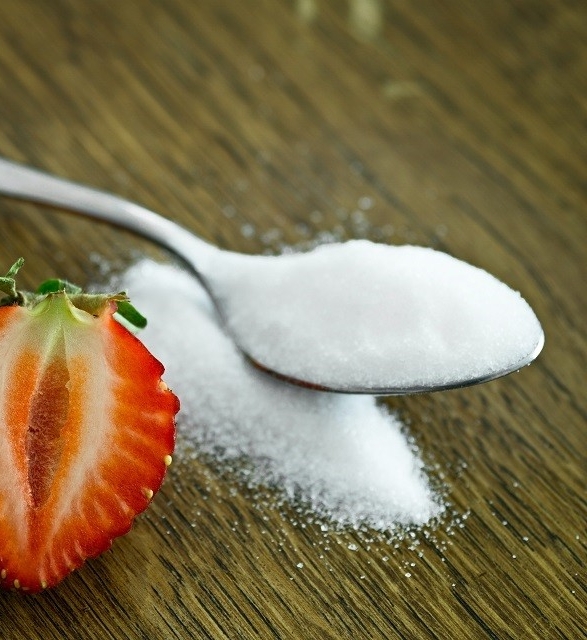article
What you need to know about sugar
What is sugar?
Sugar is a type of carbohydrate. Carbohydrates come in two main forms: simple and complex.
Carbohydrates are made from molecules called saccharides. When these occur alone or joined in pairs they are called simple carbohydrates. "Sugar" is another word for a simple carbohydrate.
Sugars are small molecules, so they are easily digested and absorbed into the bloodstream. They quickly raise blood sugar levels.
Complex carbohydrates are made up of many saccharide molecules joined in chains. These large compounds are digested more slowly and don’t raise blood sugar levels as quickly as sugars. Starch is a complex carbohydrate.
One gram of sugar provides four calories of energy. There are four grams of sugar in a teaspoon.
What are the sources of sugar in the diet?
Sugars occur naturally in foods such as fruit, vegetables and dairy products (e.g., milk, yogurt). Sugars also come in concentrated forms such as brown and white sugar, honey, maple syrup and molasses. These are not consumed alone; rather, they are added to foods and drinks (e.g., cakes, cookies, candies, soft drinks). These sugars are referred to as free sugars or added sugars.
A surprising number of processed (i.e., packaged) foods and beverages contain added sugars. A 2017 study found that 66% of packaged foods and drinks on grocery store shelves contain added sugars. These include cereals, sauces, salad dressings, ketchup and many more.
Almost 20% of the added sugar consumed by Canadians comes from soft drinks (13%) and confectioneries like candy and chocolate bars (5%). White and brown sugar, molasses, honey and syrups account for another 16% of added sugar consumption.
What are the health risks of consuming too much sugar?
Sugars provide energy. Consuming a lot of sugar can lead to a positive energy balance which contributes to weight gain and obesity. This increases the risk of cardiovascular disease, diabetes and other health problems.
Consuming too much added sugar can raise blood pressure and can increase inflammation. High added sugar intake increases the risk for heart disease and diabetes. Sugar is associated with an increased risk for cavities.
Added sugars are a source of “empty calories”: they provide energy but little—if any—nutrients. These (along with foods that contain a lot of them) take the place of healthful, nutrient rich foods in the diet.
What are the recommendations for sugar consumption?
The World Health Organization has reviewed the research on sugar consumption and its associated health risks. They recommend that adults limit their intake of added sugars to less than 10% of daily total energy intake. This would translate to about 12 teaspoons of added sugar (48 grams) for the average Canadian woman and 15 teaspoons of added sugar (60 grams) for the average Canadian man. A 591 ml bottle of Coke has 17.5 teaspoons of sugar.
What can I do to reduce the amount of sugar in my diet?
Some ways to reduce the amount of added sugar in your diet include:
- Avoid, or reduce, sugar sweetened beverages. These include regular soft drinks such as Coke, as well as other commercial beverages such as iced tea (e.g., Arizona Iced Tea), energy drinks (e.g., Red Bull), and fruit drinks (e.g., fruit punch and lemonade).
- Read food labels to choose foods that have little or no added sugar (see below).
- Reduce the amount of sugar you add to foods and drinks. This includes sugar in your coffee or tea, syrup you add to pancakes and waffles and sugar you add to cereal.
- Avoid, or reduce, candy and sweet baked goods such as cookies, cakes, pies, doughnuts, granola bars and pastries.
- Although the sugar in 100% fruit juice occurs naturally, drinking a lot of juice adds a lot of sugar to your diet. Drink fruit juices in moderation (e.g., a small glass a day). Choose fruit rather than fruit juice.
How can I identify sugar using a food label?
The nutrition facts panel that appears on most foods indicates the amount of sugar in a serving. This is the total amount of sugar and includes naturally occurring sugars as well as added sugars. To identify if a food has added sugars you will need to look at the ingredient list. However, the ingredient list does not state how much of an ingredient is in the food. Keep in mind that ingredients are listed from most to least by weight. Therefore, if you see an ingredient that indicates sugar (see below) at or near the top of the list, chances are that there is a lot of it in the food.
Ingredients that indicate sugar:
- Contain the word sugar, such as:
- Beet sugar
- Brown sugar
- Confectioner’s sugar
- Powdered sugar
- Contain the word syrup, such as:
- Barley malt syrup
- Carob syrup
- HFCS (high-fructose corn syrup)
- Maple syrup
- Corn syrup
- Contain the words "cane juice" or "fruit juice," such as:
- Dehydrated cane juice
- Fruit juice concentrate
- Contain words that end in -ose (a suffix for sugar), such as:
- Dextrose
- Fructose
- Glucose
- Mannose
- Maltose
- Sucrose
- Other names for sugar that you may see on the ingredient list are:
- Agave nectar
- Barley malt
- Caramel
- Corn sweetener
- Dextrin
- Honey
- Maltodextrin
- Maltol
- Molasses
- Muscovado
- Sweet sorghum
- Treacle
What about artificial sweeteners?
Several sugar substitutes (e.g., aspartame, acesulfame-potassium and sorbitol) are approved for use in Canada. Questions have been raised about the negative health effects and risks of sugar substitutes. The research to date is conflicting. If you choose to consume artificial sweeteners, use them in limited amounts.


